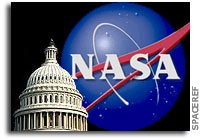House Appropriations Commitee FY 2013: Commercial crew (excerpt)

COMMERCE, JUSTICE, SCIENCE, AND RELATED AGENCIES APPROPRIATIONS BILL, 2013
The Committee on Appropriations submits the following report in explanation of the accompanying bill making appropriations for Commerce, Justice, Science, and related agencies for the fiscal year ending September 30, 2013, and for other purposes.
Page 69
Commercial crew
The Committee supports the goal of achieving independent and redundant access to the International Space Station (ISS) but remains concerned about many aspects of NASA’s approach to the commercial crew development program. First, the Committee believes that the program’s total estimated development costs of $4,868,000,000 are too high given that the current commitment to the ISS leaves NASA with only a few years to make use of commercial crew services and no sufficient additional market has been clearly demonstrated in the absence of NASA as a base customer.
Second, the current structure of the program has insufficient safeguards in place to protect the government’s interests in intellectual or physical property developed with Federal money in the event that companies are terminated from or opt to leave the program. As such, there is a risk of repeating the government’s experience from last year’s bankruptcy of the solar energy firm Solyndra, in which the failure of a high risk, government subsidized development venture left taxpayers with no tangible benefit in exchange for their substantial investment.
Third, the Administration appears to be pursuing potentially inconsistent goals for the program: (1) the achievement of the fastest, safest, most cost effective means of domestic access to the ISS, and (2) the ”seeding” of a new commercial spaceflight industry. Given the overwhelming importance of the first of these goals, any funding, time and effort expended in pursuit of the second is potentially a distraction from other necessary work, and, in an environment of fiscal constraint, a dilution of limited resources.
Finally, the program’s current acquisition strategy lacks any defined plan to transition from the planned Space Act Agreement (SAA)-based Commercial Crew Integrated Capability (CCiCap) round of awards to a Federal Acquisition Regulation (FAR)-based certification and service contract. As a result, the strategy presents a significant risk of costly, lengthy delays as NASA attempts to retroactively assess competitors’ designs on safety and other standards and companies attempt to make changes in fully mature integrated designs to address instances in which NASA cannot verify that a necessary qualification criterion has been met.
The Committee believes that many of these concerns would be addressed by an immediate downselect to a single competitor or, at most, the execution of a leader-follower paradigm in which NASA makes one large award to a main commercial partner and a second small award to a back-up partner.
With fewer companies remaining in the program, NASA could reduce its annual budget needs for the program and fund other priorities like planetary science, human exploration or aeronautics research. In addition, an accelerated downselect would allow NASA to focus its remaining funds and technical assistance resources on the most promising contender, potentially enabling that competitor to produce a final capability faster than otherwise possible. It would also allow NASA to return to its previous acquisition strategy of holding an open competition (to include current funding recipients and new entrants) and following a more traditional FAR-based management approach, avoiding a complex transition from SAAs late in the development process and allowing the government to better protect its interests in intellectual and physical property developed with taxpayer funds. Finally, this strategy is more consistent with current overarching fiscal guidance included in the fiscal year 2013 House budget resolution. In a climate of decreasing non-defense discretionary spending, the Committee does not believe that the Administration’s proposed budget runout for commercial crew is sustainable.
For all of these reasons, the Committee believes that the advantages offered by an immediate downselect and a return to FARbased contracts outweigh the potential benefits of maintaining the current program structure. As a result, the Committee directs NASA to execute the program as described above and in accordance with a fiscal year 2013 funding level of $500,000,000, which is equal to the level agreed to by Congress and the Administration in the NASA Authorization Act of 2010 (Public Law 111-267).








